 | Slack was launched in 2014, went public in 2019, and is now a global operation with more than 2,000 employees and 100,000-plus customers. But it hasn’t lost its start-up mentality. And never did it move with more speed and clarity of focus than in March 2020, when the Covid-19 crisis brought on two challenges: dramatically increasing customer demand and an extremely abrupt transition to working remotely. The company’s customer success and experience teams delivered nearly round-the-clock support free, both to existing customers and to newcomers who needed help getting set up with the product. Interviews with job candidates and the employee onboarding process were moved online. Marketing developed a public service ad for television committing to help any groups that were working on a Covid-19 response. Slack’s engineers ensured that its systems were operational 99.9% of the time in a period of soaring demand. Customers with 1,000 or 10,000 Slack users suddenly wanted to expand to 50,000. New customers wanted comprehensive proposals immediately. Organizations of all kinds had to transform the way they worked, all at once. This crisis, Butterfield writes, “has created an opportunity for us and others to become more agile, to take on changes that once seemed daunting, to reimagine organizational culture…and to reposition for future growth.” Request Free! |
